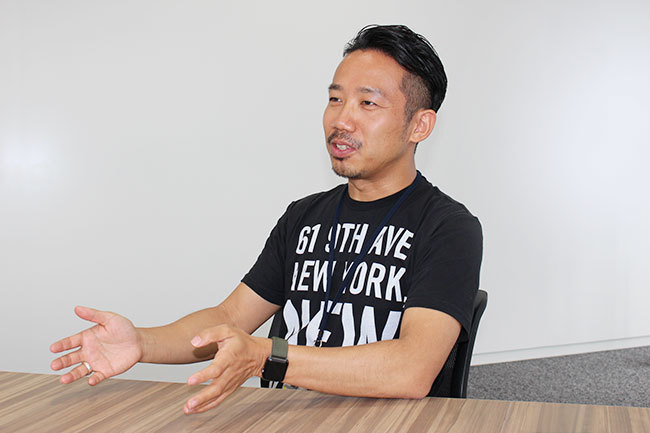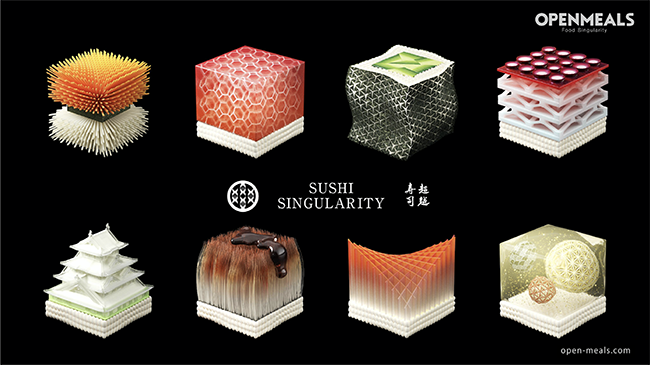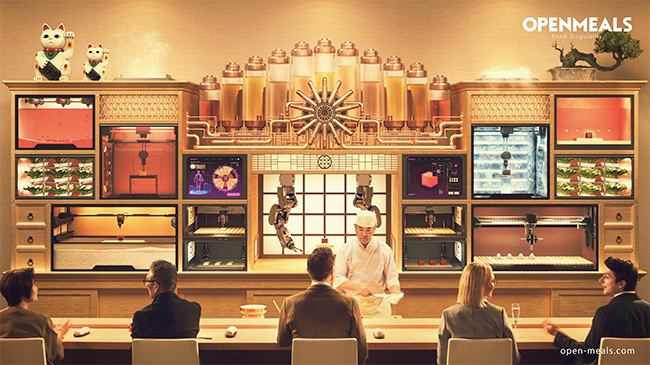Every spring, the "South by Southwest" (SXSW) festival takes place in the United States. This event draws numerous companies and creators from around the world, showcasing forward-thinking works in music, film, and interactive media. The Interactive section, where new technologies and business ideas converge, is particularly renowned for unveiling services like Twitter and Airbnb that later became global hits, capturing significant attention. This year, too, various "seeds" of business were announced.
As mentioned in the first installment of this series, Dentsu Inc. also exhibited four works under the concept "Pointless Brings Progress." This series focuses on the creators responsible for the works and their production, delving into each individual's story.
For this final installment, we feature Dentsu Inc.'s Ryosuke Sakaki (Art Director, Dentsu Creative Planning Division 3 / OPENMEALS founder). Last year, he created the project "SUSHI TELEPORTATION," which generated significant buzz with its "food teleportation" concept—digitizing food and outputting it via 3D printer. This year, he unveiled its second installment, "SUSHI SINGULARITY." We reveal Sakaki's activities that transcend the boundaries of an art director.

Ryosuke Sakaki (Art Director, Dentsu Inc. Creative Planning Division 3 / OPENMEALS founder)
Food conceived on Earth can be output and eaten in space
—Tell us about "SUSHI SINGULARITY."
It's the latest project from OPEN MEALS. It explores two major impacts predicted to occur when food becomes digitized and connected to the internet:
① Food connects "people around the world"
② Food connects with "individual bodies"
We presented this at SXSW using sushi as our motif. We're also planning a "Super Future Food Restaurant" where you can experience this future.
"OPEN MEALS" is the team advancing the "Food Transfer" project, which began four years ago. Food Transfer involves digitizing the elements that make up a dish—its shape, taste, texture, etc.—and recreating them using technologies like 3D printing.

Traditionally, eating meant consuming food prepared by family or chefs. However, once food is digitized and can be output by machines, people will be able to share their own culinary creations worldwide. For instance, in impoverished regions, during disaster relief, or even in space, having a machine would enable access to diverse dishes.
Furthermore, the digitization of food will enable people worldwide to conceive diverse dishes online, refine recipes, and share them. This could lead to a succession of innovative culinary creations.
Furthermore, a revolution will occur in the health sector. In the future, people will be able to easily check their own DNA and nutritional status within their bodies. Based on this data, it will be possible to create personalized, optimized meals tailored to each individual's physical condition, such as supplementing lacking nutrients.

Visualizing the analysis of individual physiological data to derive optimal nutritional balance
Last year, "OPEN MEALS" showcased a robotic arm-like 3D laser printer, demonstrating the ability to print sushi made in Tokyo in the United States. This introduced the concept of food transmission. Since then, they have continued R&D in collaboration with various experts and are now concretely considering opening a "super-futuristic food restaurant" utilizing food transmission technology in the near future. At this year's SXSW, we unveiled "SUSHI SINGULARITY," revealing part of the restaurant concept and the machines that will be used.
As with last year, the international response was significant. Offers and inquiries continue to pour in from both Japan and abroad. While we're already collaborating with various institutions and experts, we look forward to partnering with many more people going forward.
Applying printing mechanisms to "taste" opened up a completely different world
—Why did Art Director Sakaki start the "Food Transfer" project?
About four years ago, our company established the Communication Planning Center—a hub dedicated to solving various societal challenges, not just advertising, in a solution-neutral way. "Food Transfer" was the idea I submitted for their competition.
The initial concept originated from the work of an art director. All printed materials in the world, like posters and photos, reproduce various "visuals" by changing the mixing ratios of four colors: CMYK (Cyan, Magenta, Yellow, Black).
The spark came from wondering if this mechanism could be applied to "taste." So, we defined the four taste elements as SSSB (Sweet, Sour, Salty, Bitter) and tried it with existing printers. We filled ink cartridges with seasonings like soy sauce and vinegar and printed onto edible paper.
The result? It tasted absolutely awful (laugh). However, changing the mixing ratios did make the taste change noticeably, regardless of the quality. This showed me that if the data is properly organized, food can be reproduced through output just like color.
While printers and color expression methods are things art directors deal with routinely, shifting just one part of that mindset opened up a completely different world.
From there, we sought out researchers working on taste digitization and 3D-printed cooking, gradually expanding our team. Furthermore, the venture needed strong business potential. The food industry market was larger than imagined, and investment in food tech was rapidly increasing. Anticipating growth in the food × technology sector, we formally launched the project. Since then, we've built upon incremental progress to reach where we are today.
Unleashing the Capabilities of Advertising Creators for Society
—Please tell us why you're pursuing activities beyond the scope of an art director and your future outlook.
I've always believed design is merely a tool. What truly interests me is how it moves people's hearts and how society responds. This perspective gradually expanded my scope beyond design. I began developing integrated campaigns—from initial strategy conception to visual design, commercials, PR, and promotions—all based on my own ideas. Later, I evolved to wanting to leverage my design and creative skills for the greater good of society.
I believe there are many fields beyond advertising where the skills of an "advertising creator" can be applied, and there is still plenty of room to expand the field.
For example, if refining advertising expression through collaboration between art directors and copywriters to create better ads is "Creative Direction 1.0," then collaborating with digital creators, PR planners, and others to create more multidimensional and integrated "brand experiences" is "2.0." This is still within the advertising domain. Then, "Creative Direction 3.0" involves forming parallel teams with experts beyond advertising—university researchers, engineers, academic institutions, government bodies, legal professionals—and directing them to build future industries and ventures. I believe advertising creators' skills can evolve to this level.
I enjoy connecting people to create new value. "OPEN MEALS" also involves people from diverse industries: food data specialists, 3D printer engineers, health tech experts, chefs, designers, and more. Gathering these varied talents to build a new future is exciting, and I want to be the starting point for that.
What I can do at that moment is synthesize the diverse insights and technologies of many people and visualize them into a single picture. The "ultra-future restaurant" image visual I created for "SUSHI SINGULARITY" is one example. It wasn't just a wild fantasy; it was drawn based on conversations with experts in each field and grounded in scientific evidence. For instance, the shapes of each fabrication machine and the detailed depiction of shaping methods, or the placement of an SLS (Selective Laser Sintering) 3D printer in this specific location due to weight considerations.

Why visualize? Because it clarifies the goal we aim for and facilitates discussion even between different fields. "Visuals" are the most powerful common language and can serve as a clear compass. When I listen to each person's perspective and synthesize them into a single image, the vision becomes clearer, helping experts from various fields exchange opinions.
Synthesizing diverse perspectives into "a single picture" or "visualizing" is consistently valuable in business and represents a significant capability an art director can possess. Through OPEN MEALS, I recognized this expertise.
I believe this skill is especially essential when developing unprecedented "products," "businesses," or "industries" alongside various experts. Moving forward, I plan to systematize this visualization method, but I'll elaborate on that in a future opportunity.








